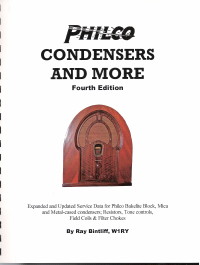Service Bulletin 289
One of the disadvantages of working on an older Philco set is rebuilding the bakelite block condensers. Nevertheless, most experienced collectors know how to do the job; normally by heating the block with a source of heat such as a heat gun until the high temperature wax (which looks like tar) softens enough that the components inside the block may be removed.
However, the really difficult part is in figuring out how the capacitors (and sometimes resistors) connect inside each different bakelite block.
Fortunately, Philco periodically published data on their bakelite block condensers. A particularly helpful issue is Service Bulletin 289, from August 1937.
Bulletin 289 has been scanned and made available for your use here. While it does not give details for every bakelite block Philco ever made, it gives enough information that most of them can either be seen or figured out by using what is provided in this Bulletin.
Philco%20Service%20Bulletin%20289More Info
Philco Repair Bench
More information on the bakelite blocks, including complete instructions on how to rebuild them, may be found at the Philco Repair Bench (Wayback Machine archived page).
Philco Condensers and More
A more comprehensive treatment of the Philco bakelite block condensers may be found in the book Philco Condensers And More, written by Ray Bintliff and now in its 4th edition. The book not only gives details on all known Philco bakelite blocks, but also covers Philco metal can condensers and tone controls made between 1930 and 1936, also. These also have capacitors embedded in high temperature wax, and the repair procedure for these is much the same as rebuilding a bakelite block.
The book is highly recommended for the serious Philco collector. The price is $22.95 plus $3.50 shipping, and is available from Antique Radio Classified. NOTE: This book had been out of print and no longer available, and Ray was kind enough to sell his remaining copies on the Phorum. It appears to be available again from Antique Radio Classified. Thank you Ray for all of the work you put into this fine publication.
